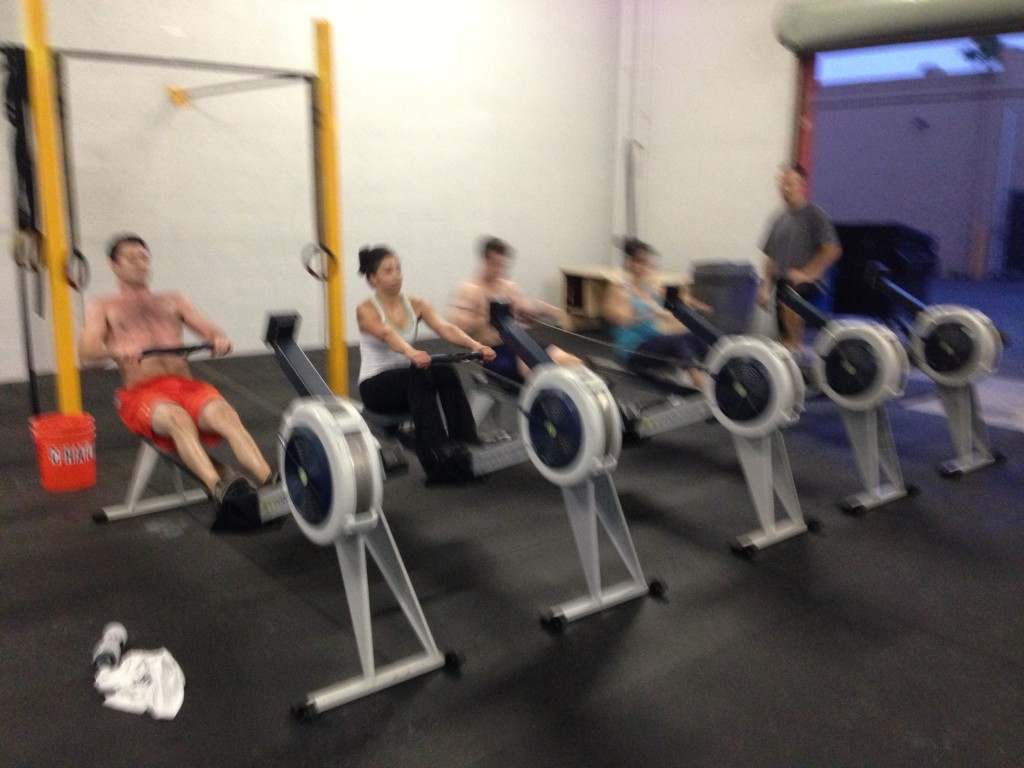The Benefits and Practice of Indoor Rowing By San Diego Personal Trainer Chris Keith
Indoor rowing is a highly valuable instrument for athletic development and a staple in Chris Keith Personal Training. Rowing is safe, effective, and appropriate for the de-conditioned or the elite athlete of any age. The question we often hear is
“What is the reason for indoor rowing?”
The simple answer is: Rowing is a coordinated muscle action that provides performance enhancement for athletes at all fitness levels, utilizing all major muscle groups while simultaneously increasing power, stamina, and endurance. In addition, rowing activates the posterior chain, which is imperative to foundational compound movements and is an exceptional vertical pulling exercise that balances the pushing/pressing movements that are employed in athletic training (i.e., push press, push-up, jerk). Most importantly, rowing simulates the opening and closing of the body experienced in all of our Olympic Weightlifting movements, specifically the clean and the snatch. Rowing is also great for weight-loss,burning up to 800 calories per hour when done properly. It is a non-weight bearing exercise that is extremely gentle on joints and great for active recovery and rehabilitation. Rowing should not be underestimated; while low impact it requires both strength and endurance and translates beautifully to the foundations of athletic training.
Hand Positioning:
The handle on the Concept 2 Rower is articulated down, making it more comfortable for your hands. When positioning your hands on the handle take a wider grip, closer to the end of the handle. Your hands should be approximately shoulder width apart, allowing your hands and arms to stay in line with your shoulders throughout the movement and permitting the elbows to remain close to your sides as you bring the handle to your chest. Your grip should be closed around the handle, compressing as you bring the handle to your chest and relaxing as you extend your arms back out.
Foot Positioning:
The heel cup (aka. footstretcher) and foot straps are found on the footboard of the rower. The heel cup is adjustable (1-5) and should be positioned so the foot strap crosses over the ball of the foot. If you are wearing shoes with laces this is typically across the bottom lace of the shoe. If you are wearing minimalist shoes (i.e., Vibram five fingers, Merrells) then you will want to adjust your feet a bit higher because your feet may slide down in the harness as you row. In contrast, if you have less flexibility or weight in your midsection you may feel more comfortable adjusting your feet higher. Once the appropriate foot position is determined, tighten the foot straps. Please note that the foot straps should not be too tight on the foot and allow for movement as you drive through your heel.
The Damper:
The damper can be found on the right-hand side of the rowers flywheel housing or fan cage and ranges from 1-10. In contrast to popular belief, the damper setting is not associated with resistance; it actually imitates the weight or size of the boat known as your drag factor. To clarify this concept, imagine that you are in an actual boat. When the drag factor is set to 10 it is the equivalent of rowing in a large row boat – 8 feet wide, 10 feet long, and impossible to flip – that is heavy and slow, but has quite a bit of inertia if you can get it moving. Setting the damper setting to 4 or 5 is likened to a racing shell – 24 feet long, 18 inches wide, and unsteady – that moves smoothly through the water after 5 strokes. If you set the damper to 1 there is no boat. In the case of indoor rowing, your drag factor increases when you set the damper higher (i.e., 10) as it allows more air into the flywheel housing and decreases as your set the damper lower (i.e., 1) permitting less air in the flywheel housing. It is important to note that the damper setting is independent of the intensity of one’s rowing and a higher damper setting does not indicate a heavier workload. While every rower is different, we often recommend keeping your damper setting between 3-6 regardless of your size or athletic ability. Lower damper settings on average contribute to the best workout and results. Higher damper settings often fatigue the muscles before you can experience all of the cardiovascular benefits of rowing.
What is the best damper setting for you?
This depends on a number of factors – Primarily bodyweight and the rowing distance that the workout requires. For illustration, a damper setting of 10 (8 for women) should only be used for rowing distances under 150 meters. This is not a rule – but a strong suggestion. Unless you have been trained with the proper stroke for years – you may cause damage to yourself at this setting when rowing longer distances.
Damper based on bodyweight – The following is a simple chart of damper settings based on weight (applied for 500meter+ piece).
250lbs – 6-7
200lbs – 5-6
175lbs – 4-6
150lbs – 3-4
125lbs – 2-3
Now that you have a general idea of where your damper should be based on your body weight let us take it a step further. Every rower is different. If you want to make sure that each rower you utilize has the same “drag factor” there is a function that lets you determine exactly where to set your damper. To find the drag factor on the rower go to options and the last selection is “more options” under which is “Drag Factor,” row for at least 10 strokes and your drag factor will appear, adjust the damper as necessary.
The following is a basic chart regarding recommended drag:
250lbs – 139
200lbs – 132
175lbs – 125
150lbs – 120
125lbs – 114
These drags are considered in the rowing world to be the most efficient for how a rower works. These drag factors rely on endurance and aerobic ability more then anaerobic. Moving higher to the 10 setting emphasizes strength more and more – but subsequently takes much more strength to move the fan making you tired before you can reap all of the benefits of rowing.
Rowing Technique
The basic rowing stroke is comprised of four different components:
- The catch
- The drive
- The finish
- The recovery
The catch initiates the stroke with the hands evenly grasping the handle, the seat is slid forward, the knees bent, and the arms fully extended.
The drive then begins by pressing through the heels and extending the legs. The torso remains in the 11 o’clock position while the arms slowly pull towards the chest.
In the finish, the legs extend completely and then the hips open, driving the torso back to the 1 o’clock position. During the finish the arms pull all the way to the lower chest/upper abdomen (approximately to the bottom of the chest bone).
During the recovery, it is important to first extend the arms, begin to close the hip, bend your legs, and then lean forward from the hips to the 1 o’clock position. Simultaneously, slide forward and initiate the catch. The chest should remain up and the shoulders back throughout the stroke. Additionally, the handle and chain cable should continue to move in a straight line during the four phases of the stroke.
The basic rowing stroke should be performed in a continuous, fluid movement; maximizing both stroke power and efficiency. We like to say “Go Hard on the pull (drive and finish), and Go Yoga on the return (recovery),” indicating a powerful initiation and a relaxed recovery.
The Display
The display will turn on when you press the “menu/back” button or if you begin rowing. You can either begin by pressing “Just Row” or “Select a Workout.” Select a workout has five pre-set workouts. The most commonly used will be the 2000 meter located at the top of the screen or the 500 meter located at the bottom. When you begin rowing the strokes per minute (s/m) will be in the top right corner of your display, aim for a stroke rate between 24 and 30 strokes per minute. The middle of the display will indicate your average speed for 500 meters (ave/500m). Keeping track of your 500 and 2000 meter times is a wonderful way to track your rowing performance overtime, making your gains visible.
The Force Curve Display.The force curve display is a helpful way to evaluate the efficiency and power of your rowing stroke. It graphically represents the total force applied during the rowing stroke, indicating the power of your legs, back, and arms during the drive. The ideal curve is a bell shaped curve – peaked like a hill – and suggests a solid effort through the stroke. If your force curve resembles the letter M, focus on smoothing out the transition from legs to back to arms. If you only have half a curve – primarily the down-slope – then you are exploding at the catch and can play with smoothing out the force applied continuously through the movement. To get to the force curve display, press “change display” on the rower until you see it in the lower half of the display – it will be a blank area with one line, Kg, and lbs on the right side.
There is no doubt that rowing is a valuable tool for reaching your fitness goals. Rowing activates all of your major muscle groups and provides strength, aerobic, and anaerobic conditioning. In addition, rowing promotes flexibility and mobility because it exercises muscles through a wide range of motion. While rowing is a natural motion, proper rowing technique requires consistent practice to develop impeccable posture, perfectly timed leg, trunk, and arm motion, as well as increased endurance. Chris Keith strongly believes in the benefits of rowing and our knowledgeable trainers are available to assist you in your rowing development.



